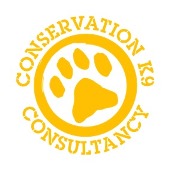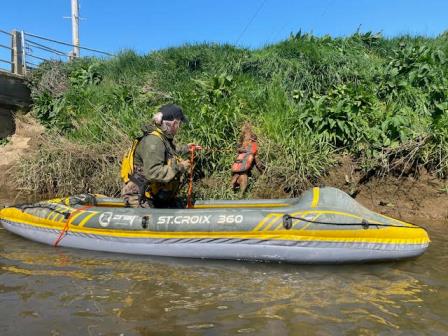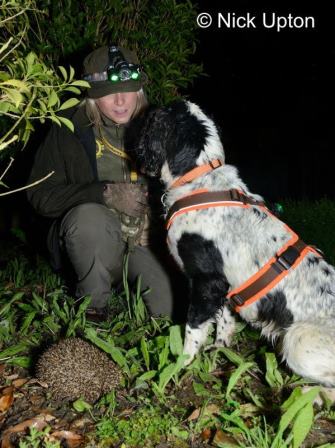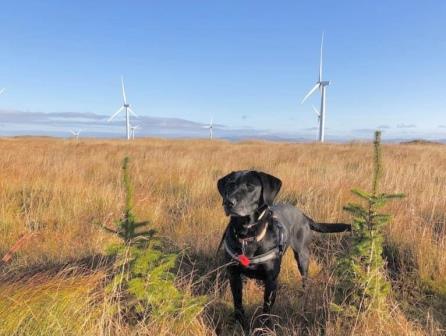Conservation K9s – A helping Paw to find endangered Species
This post is greater than 6 months old - links may be broken or out of date. Proceed with caution!

Louise Wilson is the Director and founder of Conservation K9 Consultancy (CK9C), where she trains and handles specialist detection dogs for a range of conservation purposes, from ecological surveys, research searches to wildlife monitoring for endangered or invasive species.

An expert in her field, Louise has a long and varied background in dog training, having trained and handled drugs and explosives detection dogs over the last 18 years. Other wildlife projects have involved dormice, water voles, wolverines, dormouse, wildlife poison, wolves, bear, cheetah, mountain lions, otters, salamanders, great crested newts, frog Carcasses, invasive beetles, lynx, pine martens, hedgehogs, and bat carcasses to name a few.
UK Projects
CK9C have dogs that sniff out water vole latrines and burrows, but can also detect tiny amounts of scat, offering unparalleled insight into water vole range. Environmental damage is minimised by dog use, as traditional search methods sometimes involved flattening reeds to hand search for water vole evidence, whereas a 16-kilogram conservation dog can work their way through the reeds with little impact. When searching, the dog’s handler Louise is purely led by the dog when on conducting wildlife monitoring, without adding any bias to the outcome of the search.
Louise’s expertise lies in her dog’s ability; she also works alongside target species specialists such as conservationists, biologists, and researchers to ensure she has the right species advice and guidance.
Many owners think their dog could be a good conservation detection dog, as they often find hedgehogs when out at night. However, that predatory instinct is not useful in conservation. Louise is looking for a dog which is neither too interested in, nor too scared by its target, such as hedgehogs. The welfare of the target species is always a priority, and CK9C have worked with the People's Trust for Endangered Species, the British Hedgehog Preservation Society and Hartpury University for over 3 years whilst training and working their hedgehog detection dogs.

Bat and bird carcass detection – primarily used on wind turbine sites – demonstrates the remarkable proficiency of detection dogs. Research papers suggest that a dog is at least 96% efficient in detecting all bat carcasses on a site, compared with 11% for humans. The rise of renewable energy sources means it’s essential to minimise and monitor their impact on birds and bats and CK9C have dog teams available for searches UK wide.
It took Louise years of giving presentations, demonstrations and raising awareness with her bat carcass detection dog before the approach was widely accepted. It is intriguing that while there was initial scepticism towards wildlife detection dog use in this field, virtually nobody questioned whether Louise and her explosive detection dogs had completed a research paper with her search dog’s success in her previous role, which is usually what is questioned when promoting wildlife detection dogs.
Luna, the pine marten detection dog, was revealing the endangered species’ secrets within four weeks of starting her training. On her first outing, Luna led Louise into a swampy area, which the ecologists doubted would suit a pine marten. Yet when the scat Luna indicated on was tested, it was indeed pine marten. A vital aspect of scat detection is that the animals themselves are not disturbed.
Conservation Dog Handler Courses and Training
It is imperative for the conservation, ecology and the detection dog industry that all dogs used in wildlife detection are properly trained and have established a relationship with their handler. Detecting the scent may come naturally, but the dog must learn not to interact with their target, and to indicate their presence to their handler. Similarly, the handler must be able to read their dog. The accredited courses Louise now offers at CK9C training centre at Erddig National Trust property emphasise that handler and dog must be a team. To properly establish a wildlife detection partnership requires extensive training and mentoring for both handler and dog.

CK9C centre - opened in March 2021 – enables Louise to offer a range of accredited conservation dog handler skills courses and events. Supporting conservationists to achieve their mission is a passion for Louise. Her mentoring and coaching programmes are taken up not just by UK handlers but also her international conservation clients. Partnering with a local university allows Louise to develop and offer exciting professional development opportunities.
Over the years, Louise has adjusted the dog training methods she initially employed when training contraband detection dogs. It takes different training techniques, different understanding and a different relationship when working dogs in wildlife detection and at CK9C they have years of experience and practice to help give you the best training and expertise.
Currently, Louise is working on several exciting projects to help with ecological monitoring which should be released soon. As conserving wildlife become more of a challenge globally, conservation dogs may well provide efficient, effective support.
Rescue dogs to Conservation Dogs
All of CK9C own dogs are rescue dogs – and Louise’s criteria for choosing them is surprising. She usually helps rehome the dogs that make the worst pet. This is because working dogs need drive, determination and a relentless behaviour; qualities which can often cause issues in a family pet.
Despite adoring her dogs, and giving them fulfilled lives and living with them happily, Louise is clear that they are not – nor should they be classed as a pet. A conservation dog must feel at ease in their environment, and be free to sniff wherever they want with independence and confidence. Around the house, if Louise finds her dogs on a kitchen surface in search of their target odour or reward, Louise must praise them for problem solving. We have different restraints and requirements for pet dogs than we have for working dogs and trying to find a dog that can do both 100% is near impossible.
CK9C’s Conservation dogs might be the dogs which were once rejected as pets, but they may well be the ones who support successful scientific outcomes, and sniff out success for endangered species.
Facebook – conservation k9 consultancy
Instagram- @conservationk9uk
Twitter ConservationK9sUK @vk9consultant
More from Conservation K9 Consultancy